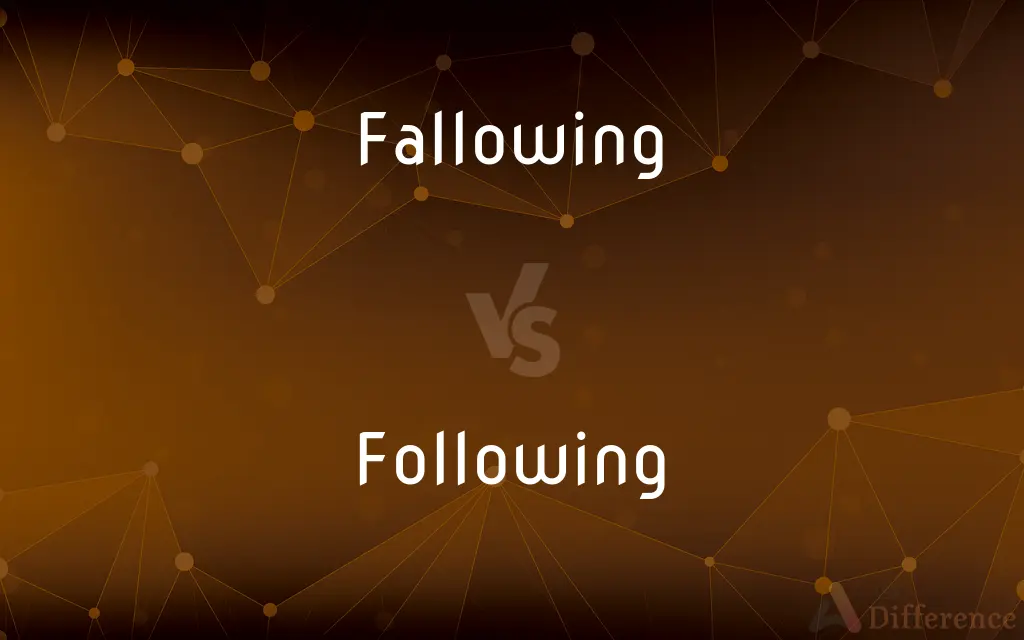Fallowing vs. Following — What's the Difference?
By Urooj Arif & Fiza Rafique — Updated on May 3, 2024
Fallowing involves leaving land unplanted to restore fertility, whereas following refers to the act of coming or going after something or someone.

Difference Between Fallowing and Following
Table of Contents
ADVERTISEMENT
Key Differences
Fallowing is an agricultural practice where land is intentionally left unplanted for a period to recover its fertility and reduce soil erosion. On the other hand, following generally means to come after or behind, in a sequential or physical sense.
In the context of farming, fallowing helps to break the cycle of pest and disease buildup, improving soil health through natural processes. Whereas, following in a procedural context refers to adhering to steps, instructions, or movements that come after those previously mentioned.
Following means to subscribe or keep track of another person's activities, typically on social media. Conversely, fallowing has no direct social connotation but is purely an agricultural term.
While fallowing is a planned and beneficial inactivity in agriculture, following is an active engagement, whether it be in following directions, trends, or people.
Fallowing benefits the environment by conserving water and encouraging biodiversity. In contrast, following can either foster community and knowledge or lead to privacy concerns and information overload, depending on the context.
ADVERTISEMENT
Comparison Chart
Definition
Leaving land unplanted to restore fertility.
Coming or going after something or someone.
Primary Context
Agriculture
General use, social media, procedures
Purpose
Restore soil health, prevent erosion.
Gain information, maintain order.
Associated Activities
Soil recovery, biodiversity enhancement.
Observing, subscribing, learning.
Outcome
Improved agricultural productivity.
Knowledge acquisition, social interaction.
Compare with Definitions
Fallowing
A strategy to conserve water and restore land.
By fallowing, they managed to accumulate moisture in the soil.
Following
The act of coming after something in sequence.
She had a hard time following the new rules.
Fallowing
The practice of leaving fields unplanted to rejuvenate.
They practiced fallowing to enhance the soil's nutrient content.
Following
Continuing along a path or after an event.
Following the path, they reached a beautiful lake.
Fallowing
An agricultural method to control pests naturally.
Fallowing the field reduces pest populations without chemicals.
Following
Adhering to instructions or guidance.
Following the manual, he assembled the furniture correctly.
Fallowing
A farming technique to prevent soil degradation.
Fallowing every other season helps prevent erosion.
Following
Tracking someone’s updates on social media.
He enjoys following celebrities on Instagram.
Fallowing
A cyclical period of rest for farmland.
The farm undergoes fallowing as part of a sustainable agriculture practice.
Following
Being a fan or supporter of someone.
His following has grown significantly since the concert.
Fallowing
Plowed but left unseeded during a growing season
Soil erosion from fallow fields.
Following
Following is a 1998 independent neo-noir crime thriller film written and directed by Christopher Nolan. It tells the story of a young man who follows strangers around the streets of London and is drawn into a criminal underworld when he fails to keep his distance.
Fallowing
Left unplowed and unseeded
Fields that had been fallow for many years.
Following
Coming next in time or order
In the following chapter.
Fallowing
Characterized by inactivity
A fallow gold market.
Following
Now to be enumerated
The following people will report for duty.
Fallowing
Land left unseeded during a growing season.
Following
Blowing in the same direction as the course of a ship or aircraft. Used of wind.
Fallowing
The act of plowing land and leaving it unseeded.
Following
A group or gathering of admirers, adherents, or disciples
A lecturer with a large following.
Fallowing
The condition or period of being unseeded.
Following
The item or items to be mentioned next
Please buy the following.
Fallowing
To plow (land) without seeding it afterward.
Following
Subsequent to; after
Following dinner, brandy was served in the study.
Fallowing
To plow and till (land), especially to eradicate or reduce weeds.
Following
Coming next, either in sequence or in time.
See the following section.
Fallowing
Present participle of fallow
Following
About to be specified.
The following words have no definition...
Fallowing
A period during which a field is left fallow.
Following
(of a wind) Blowing in the direction of travel.
The following wind sped us on our way.
Following
After, subsequent to.
Following the meeting, we all had a chat.
Following
A group of followers, attendants or admirers; an entourage.
He had a loyal following.
Following
Vocation; business; profession.
Following
(with definite article, treated as singular or plural) A thing or things to be mentioned immediately after.
The following is a recommendation letter from the president.
The following are the three most important questions.
Following
Present participle of follow
Following
One's followers, adherents, or dependents, collectively.
Following
Vocation; business; profession.
Following
Next after; succeeding; ensuing; as, the assembly was held on the following day.
Following
In the field of a telescope) In the direction from which stars are apparently moving (in consequence of the earth's rotation); as, a small star, north following or south following. In the direction toward which stars appear to move is called preceding.
Following
A group of followers or enthusiasts
Following
The act of pursuing in an effort to overtake or capture;
The culprit started to run and the cop took off in pursuit
Following
Going or proceeding or coming after in the same direction;
The crowd of following cars made the occasion seem like a parade
Tried to outrun the following footsteps
Following
In the desired direction;
A following wind
Following
Immediately following in time or order;
The following day
Next in line
The next president
The next item on the list
Following
About to be mentioned or specified;
The following items
Common Curiosities
Can fallowing help with pest control?
Yes, fallowing can help reduce pest populations by disrupting their life cycles with periods when crops are not grown.
What does following mean?
Following can mean either coming after something in sequence or monitoring someone’s activities, especially on social media.
What are the environmental impacts of fallowing?
Fallowing typically has positive environmental impacts, such as increased biodiversity and better water retention in the soil.
Why do farmers use fallowing?
Farmers use fallowing to improve soil health, manage pests and diseases, and conserve water.
What are the benefits of following instructions?
Following instructions can lead to more accurate and successful outcomes in tasks, ensuring safety and efficiency.
How does following someone on social media work?
Following someone on social media involves subscribing to their updates to keep track of their posts and activities.
What should I consider when choosing to follow someone online?
Consider the relevance, value, and security of the information shared by the person you choose to follow.
Is following always physical, like following someone in a crowd?
Following can be physical or virtual, such as following someone in a crowd or subscribing to someone’s social media account.
How do I know who to follow for reliable information?
Look for credibility, expertise, and consistent delivery of accurate and useful information when choosing whom to follow.
What is fallowing?
Fallowing is the agricultural practice of leaving land unplanted for a period to restore its fertility and reduce soil erosion.
Is fallowing beneficial for all types of soil?
Fallowing is generally beneficial, but its effectiveness can vary based on soil type, climate, and local ecosystem characteristics.
How often should land be fallowed?
The frequency of fallowing depends on factors such as crop type, soil condition, and local agricultural practices.
Can fallowing be used in modern agriculture?
Yes, fallowing is still a valuable practice in modern sustainable agriculture for managing resources and improving soil health.
Does following trends have any risks?
Following trends can sometimes lead to adopting practices that are not suited to one’s individual needs or that may quickly become outdated.
Can fallowing be temporary, or is it a permanent change to land use?
Fallowing is usually a temporary measure in agricultural rotation and not a permanent change to land use.
Share Your Discovery

Previous Comparison
Datum vs. Date
Next Comparison
Perch vs. ZanderAuthor Spotlight
Written by
Urooj ArifUrooj is a skilled content writer at Ask Difference, known for her exceptional ability to simplify complex topics into engaging and informative content. With a passion for research and a flair for clear, concise writing, she consistently delivers articles that resonate with our diverse audience.
Co-written by
Fiza RafiqueFiza Rafique is a skilled content writer at AskDifference.com, where she meticulously refines and enhances written pieces. Drawing from her vast editorial expertise, Fiza ensures clarity, accuracy, and precision in every article. Passionate about language, she continually seeks to elevate the quality of content for readers worldwide.
















































